【2015中考复习方案】2015届九年级英语复习课件(山西):第1课时 Starter+Unit+1—Unit+4(共38张PPT)
文档属性
| 名称 | 【2015中考复习方案】2015届九年级英语复习课件(山西):第1课时 Starter+Unit+1—Unit+4(共38张PPT) | 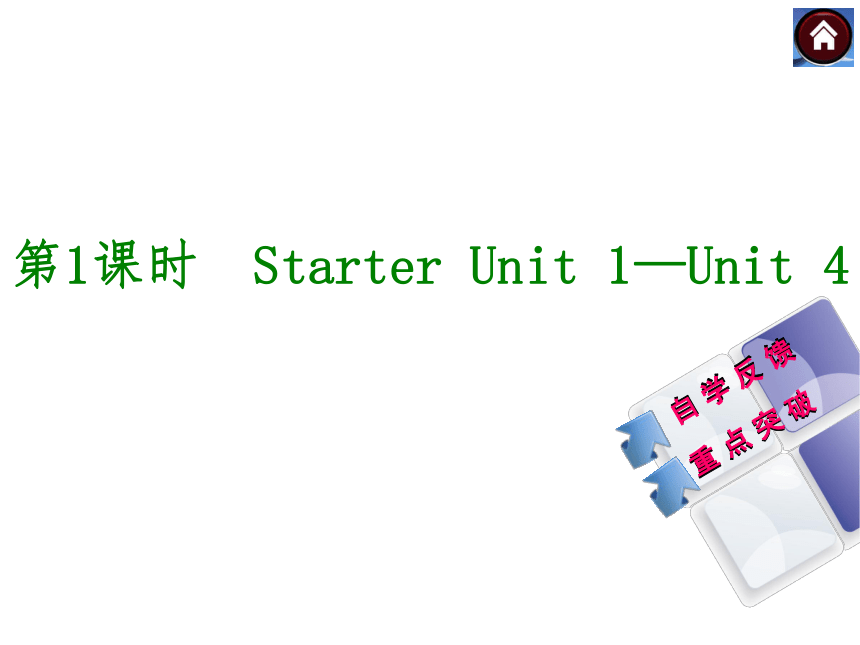 | |
| 格式 | zip | ||
| 文件大小 | 187.9KB | ||
| 资源类型 | 教案 | ||
| 版本资源 | 通用版 | ||
| 科目 | 英语 | ||
| 更新时间 | 2014-12-12 21:49:29 | ||
图片预览

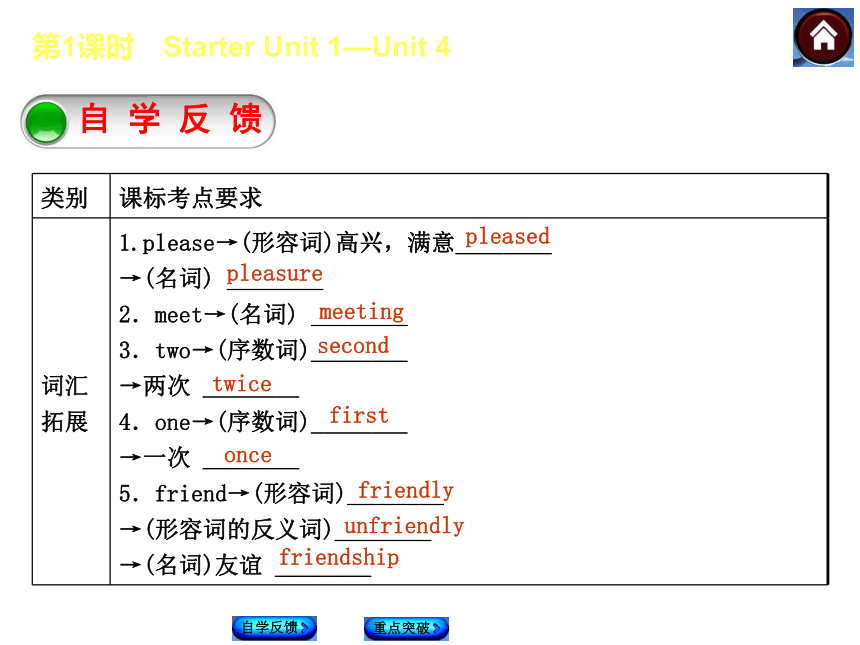
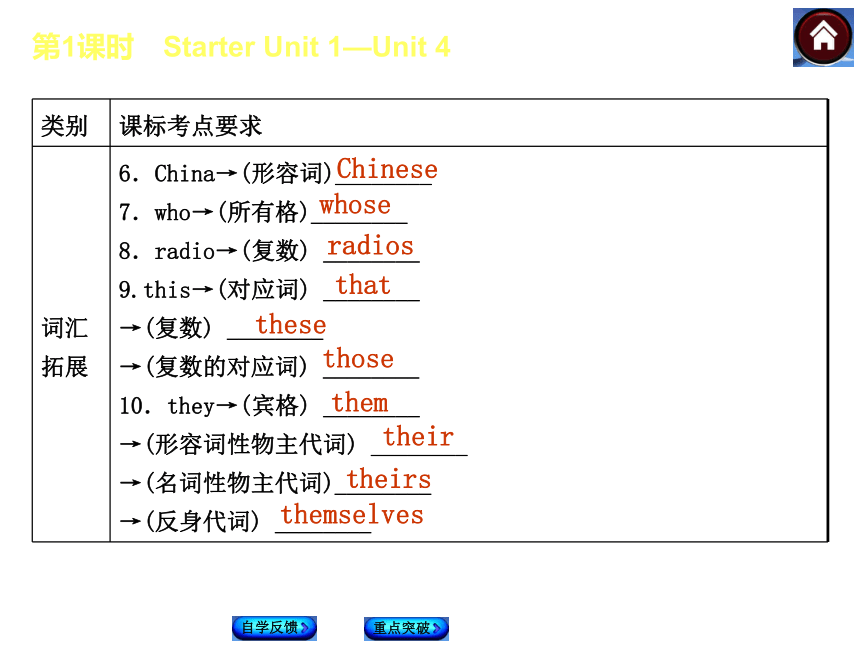
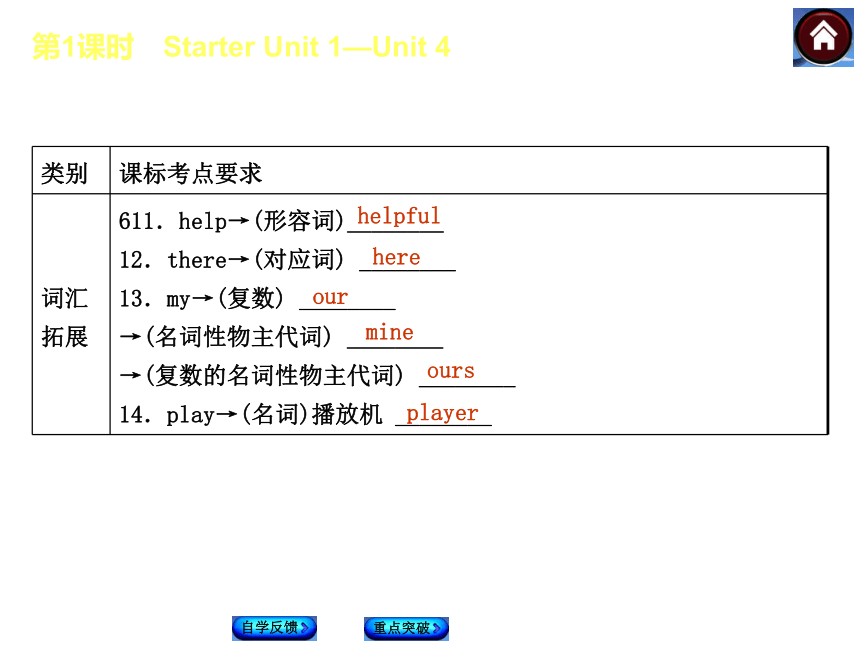
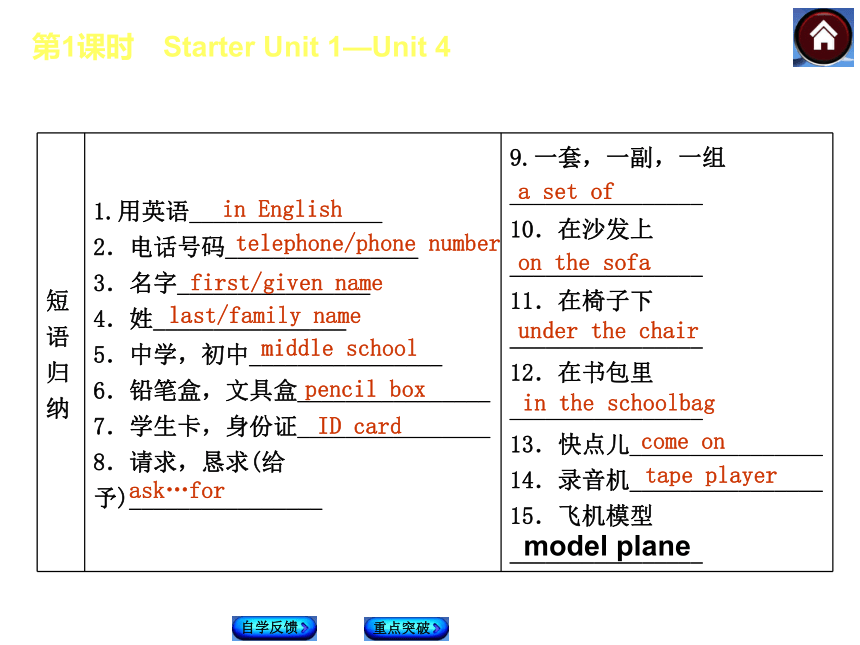
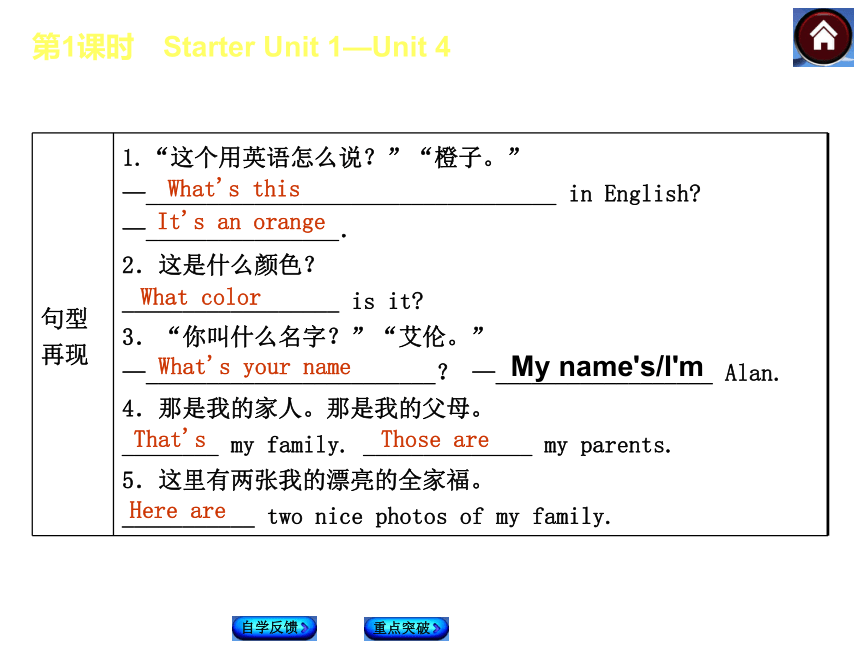

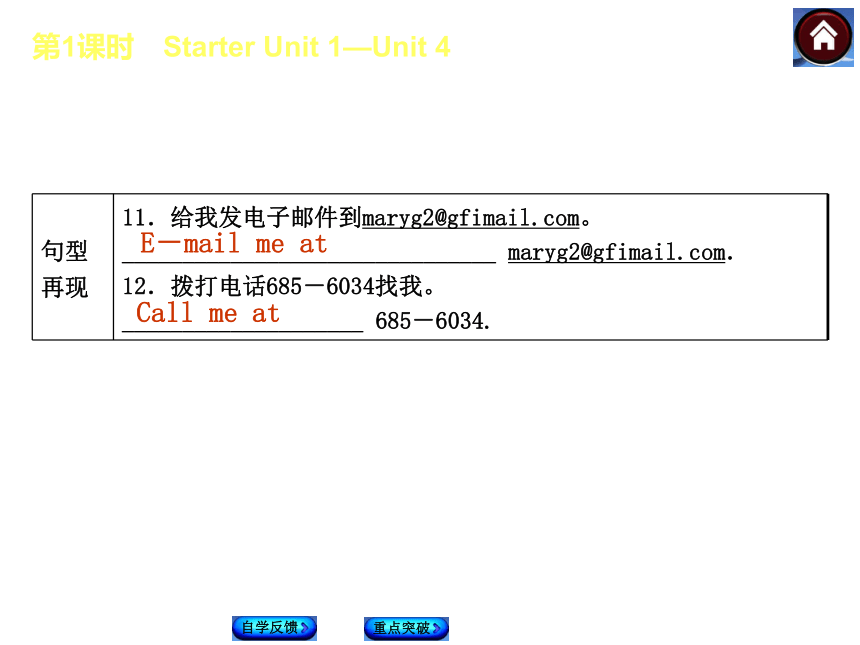
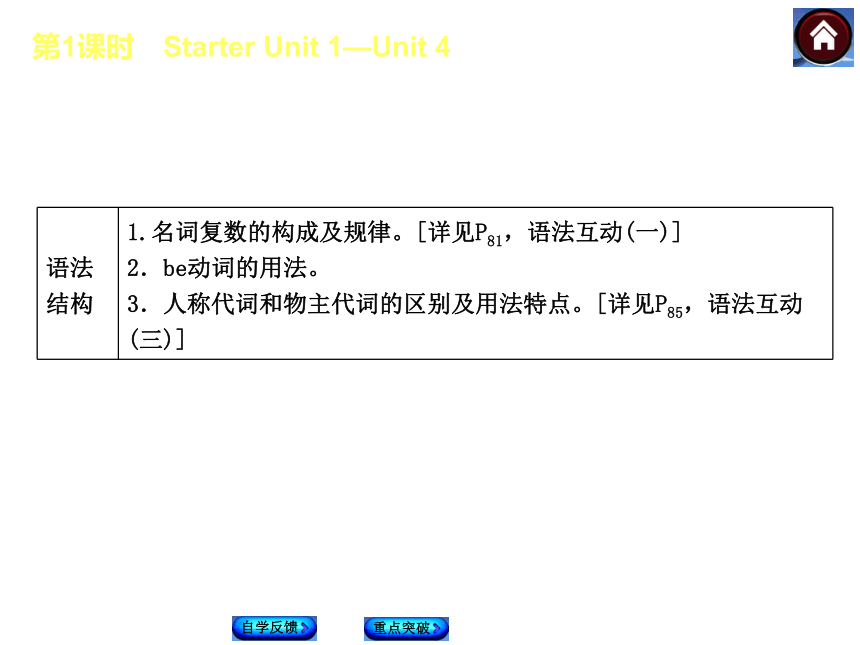

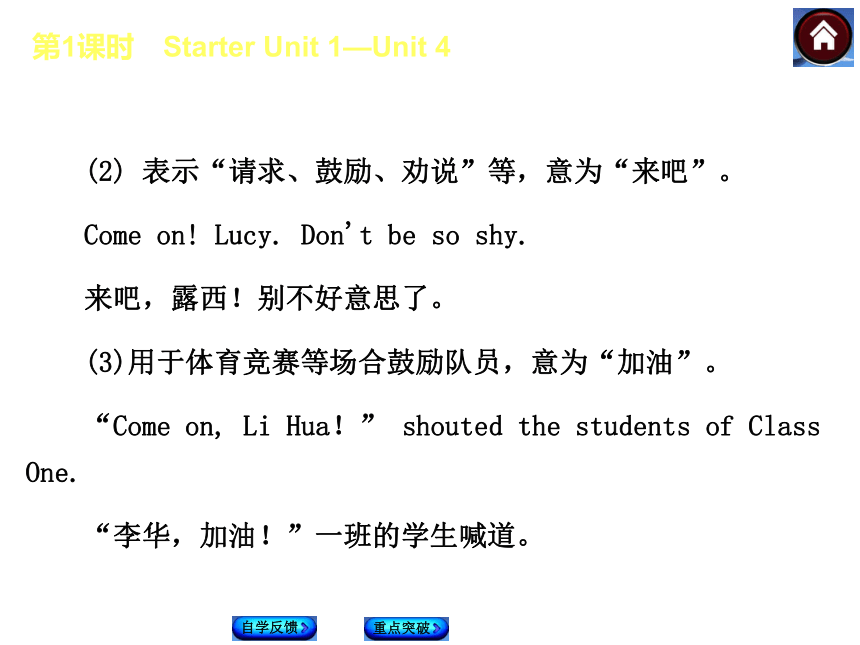

文档简介
课件38张PPT。第1课时 Starter Unit 1—Unit 4第1课时 Starter Unit 1—Unit 4自 学 反 馈 自学反馈重点突破 pleased pleasure meeting second twice first once friendly unfriendly friendship 第1课时 Starter Unit 1—Unit 4自学反馈重点突破 Chinese whose radios that these those them their theirs themselves 第1课时 Starter Unit 1—Unit 4自学反馈重点突破 helpful here our mine ours player 第1课时 Starter Unit 1—Unit 4自学反馈重点突破 in English telephone/phone number first/given name last/family name middle school pencil box ID card ask…for a set of on the sofa under the chair in the schoolbag come on tape player model plane 第1课时 Starter Unit 1—Unit 4自学反馈重点突破 What's thisWhat color It's an orangeWhat's your name My name's/I'm That'sThose areHere are 第1课时 Starter Unit 1—Unit 4自学反馈重点突破 Excuse me Is this thank you Are these they aren't They're hers What/How aboutThank you for your help welcome Ask for 第1课时 Starter Unit 1—Unit 4自学反馈重点突破 E-mail me at Call me at 第1课时 Starter Unit 1—Unit 4自学反馈重点突破 第1课时 Starter Unit 1—Unit 4重 点 突 破 词汇点睛自学反馈重点突破 ● come on 快点
[点拨] come on可用于以下场合:
(1)表示“快点儿”时,用来催促别人。
Come on! It's getting dark. 快点!天要黑了。第1课时 Starter Unit 1—Unit 4(2) 表示“请求、鼓励、劝说”等,意为“来吧”。
Come on! Lucy. Don't be so shy.
来吧,露西!别不好意思了。
(3)用于体育竞赛等场合鼓励队员,意为“加油”。
“Come on, Li Hua!” shouted the students of Class One.
“李华,加油!”一班的学生喊道。自学反馈重点突破 第1课时 Starter Unit 1—Unit 4[拓展] come的相关短语:
come in 进来 come out 出来,出版
come from来自 come back 回来
come true 实现,成为现实自学反馈重点突破 第1课时 Starter Unit 1—Unit 4巧辨异同自学反馈重点突破 ● 1 house/home/family
[辨析] 巧记不同的“家”:“房子”(house)里住着 “一家人”(family),这就是“家”(home)。
[拓展] family作整体概念“家庭”讲时,看作单数;作“家庭成员”讲时,看作复数。home有“家乡,故乡”之意。
Mr. Richard's family is very large.
理查德先生家是一个大家庭。(单数)第1课时 Starter Unit 1—Unit 4My family are very well.
我的家人身体都很好。(复数)自学反馈重点突破 第1课时 Starter Unit 1—Unit 4自学反馈重点突破 ● 2 one/it 第1课时 Starter Unit 1—Unit 4I don't like red apples. Please give me some green ones.
我不喜欢红苹果,请给我一些青苹果。
There is some water here, but it is not clean.
这里有些水,但不干净。自学反馈重点突破 第1课时 Starter Unit 1—Unit 4自学反馈重点突破 ● 3 good/fine/nice/well 第1课时 Starter Unit 1—Unit 4He cannot speak English well, but his Chinese is very good. 他英语说得不流利,但汉语说得很好。(well是副词, good是形容词)
I'm quite well. 我很健康。(well是形容词)
It is a fine day today. 今天是个好天气。(fine是形容词)自学反馈重点突破 第1课时 Starter Unit 1—Unit 4● 4 say/speak/talk/tell
(1)say强调说话的内容;还可表示“(某处)写有……”。
I can say it in English. 我能用英语说它。
(2)speak 作不及物动词时,强调说话的动作;作及物动词时,后面加语言。
The baby can't speak.这个婴儿不会说话。
Yang Lin speaks English well.
杨林英语说得很好。自学反馈重点突破 第1课时 Starter Unit 1—Unit 4(3)talk强调两个人之间的谈话,常用于talk with/to sb. (和某人交谈)和talk about sth. (谈论某事)。
She is talking with Lucy in English.
她正在和露西用英语交谈。
(4)tell意为“告诉,讲述”,后面常接双宾语。
Lucy told me the good news.
露西告诉了我这个好消息。自学反馈重点突破 第1课时 Starter Unit 1—Unit 4● 5 look for/find/find out
(1)look for意为“寻找”,强调找的动作和过程。
(2)find意为“找到,发现”,强调找的结果。
(3)find out意为“查出,获知”,强调经过研究、调查而得知。
Can you find out what time the train will leave?
你能查出火车什么时候开吗?
I looked for my book in my schoolbag, but I couldn't find it. 我在书包里找我的书,但是没有找到。自学反馈重点突破 第1课时 Starter Unit 1—Unit 4● 6 some/any
(1)some和any都意为“一些”,修饰可数名词复数或不可数名词。
(2)some常用在肯定句中,any多用于否定句、疑问句及条件句中。
Give me some tea.给我一些茶。
Are there any desks in the classroom?
教室里有课桌吗?自学反馈重点突破 第1课时 Starter Unit 1—Unit 4[注意] 在下列情况下应用some:
(1)在表示请求、邀请、建议的疑问句或说话人希望得到对方肯定回答的疑问句中。
(2)在肯定句中,any修饰单数可数名词时,意为“任何一个”,some修饰单数可数名词时,表示“某一个”。自学反馈重点突破 第1课时 Starter Unit 1—Unit 4● 7 always/usually/often/sometimes/seldom/never
频度从强到弱递减:always>usually>often>sometimes>seldom>never,具体如下:
always 总是,一直;usually 通常;often 经常,常常;sometimes 有时,不时;seldom 很少,几乎没有;never 从来不,未曾
[注意] 一般来说,频度副词通常位于be动词、助动词或情态动词之后,行为动词之前。sometimes比较活跃,还可位于句首或句尾。对频度副词提问用how often。自学反馈重点突破 第1课时 Starter Unit 1—Unit 4● 8 Excuse me./Sorry./Pardon?
三者分别用于以下场合:自学反馈重点突破 第1课时 Starter Unit 1—Unit 4句型透视自学反馈重点突破 ● 1 What about this dictionary?
这本词典(是谁的)呢?
[点拨] “What/How about…?”意为“……怎么样?”,其后接名词、代词或动词-ing形式。常用在以下场合:
(1)向对方提出建议或请求。
What about going out for a walk?
出去散散步好吗?第1课时 Starter Unit 1—Unit 4(2)征询对方的看法或意见。
What about her playing the violin?
(你认为)她的小提琴拉的怎么样?
(3)询问天气情况或身体状况。
What about the weather in your hometown?
你家乡的天气如何?自学反馈重点突破 第1课时 Starter Unit 1—Unit 4(4)寒暄时用作承接上下文的转折语。
I am from Beijing. What about you?
我来自北京,你呢?自学反馈重点突破 第1课时 Starter Unit 1—Unit 4● 2 Thank you for your help, Anna.
安娜,谢谢你的帮助。
[点拨] thanks for…与thank you for…同义, 表示“因……表示感谢”,介词for后接名词或动词-ing形式。
[拓展] thanks to意为“由于,多亏”,其中to为介词,并非不定式符号。 自学反馈重点突破 第1课时 Starter Unit 1—Unit 4● 3 E-mail me at maryg2@gfimail.com.
给我发邮件到maryg2@gfimail.com。
Call me at 685-6034.
拨打电话685-6034找我。
[点拨] “e-mail sb. at+电子邮箱地址”表示“给某人发邮件到……邮箱”;“call sb. at+电话号码”表示“拨打电话……找某人”。自学反馈重点突破 第1课时 Starter Unit 1—Unit 4[拓展] call 还有“拜访”之意,常用搭配有call on +某人;call at +某地。自学反馈重点突破 第1课时 Starter Unit 1—Unit 4即时自测自学反馈重点突破 Ⅰ.单项选择
1.I'm John Black. My first name is ________.
A.John B.Black C.John Black A 英文名字的构成:名在前,称为first/given name;姓在后,称为last/family name。故选A。第1课时 Starter Unit 1—Unit 42.Li Ming is________. He is in ________.
A.China; China B.Chinese; Chinese
C.Chinese; China自学反馈重点突破 C 第一空表示“中国人”,第二空表示“中国”。第1课时 Starter Unit 1—Unit 43.—Thanks for your help.
—________.
A.No, thanks B.Let me see
C.You're welcome自学反馈重点突破 C 第1课时 Starter Unit 1—Unit 44.—Do you have a red bike?
—No, I have a black ________.
A.it B.one C.ones自学反馈重点突破 B 这里用one来指代上文提到的bike这一类中的一辆。第1课时 Starter Unit 1—Unit 45.________!Mr. Li is waiting for us.
A.Come in B.Come on C.Come out自学反馈重点突破 B 由“Mr. Li is waiting for us.”可知是催促对方,故选B。第1课时 Starter Unit 1—Unit 4Ⅱ.选词填空
(A)根据句意,用say, speak, tell或talk 的适当形式填空。
1.Can you ________ it in Chinese?
2.Uncle Wang is going to ________ us a story this evening.
3.Now Jim can ________ a little Chinese.自学反馈重点突破 say tell speak 第1课时 Starter Unit 1—Unit 44.Kate, who did you ________ with just now?
(B)根据句意,用some或any填空。
5.I can see ________ interesting toys in the room.
6.—Could I have ________ milk?
—Sure. There is ________ in the fridge.
7.Are there ________ pencils in your pencil box?
8.There isn't ________ beef on the plate.自学反馈重点突破 talk some some some any any
[点拨] come on可用于以下场合:
(1)表示“快点儿”时,用来催促别人。
Come on! It's getting dark. 快点!天要黑了。第1课时 Starter Unit 1—Unit 4(2) 表示“请求、鼓励、劝说”等,意为“来吧”。
Come on! Lucy. Don't be so shy.
来吧,露西!别不好意思了。
(3)用于体育竞赛等场合鼓励队员,意为“加油”。
“Come on, Li Hua!” shouted the students of Class One.
“李华,加油!”一班的学生喊道。自学反馈重点突破 第1课时 Starter Unit 1—Unit 4[拓展] come的相关短语:
come in 进来 come out 出来,出版
come from来自 come back 回来
come true 实现,成为现实自学反馈重点突破 第1课时 Starter Unit 1—Unit 4巧辨异同自学反馈重点突破 ● 1 house/home/family
[辨析] 巧记不同的“家”:“房子”(house)里住着 “一家人”(family),这就是“家”(home)。
[拓展] family作整体概念“家庭”讲时,看作单数;作“家庭成员”讲时,看作复数。home有“家乡,故乡”之意。
Mr. Richard's family is very large.
理查德先生家是一个大家庭。(单数)第1课时 Starter Unit 1—Unit 4My family are very well.
我的家人身体都很好。(复数)自学反馈重点突破 第1课时 Starter Unit 1—Unit 4自学反馈重点突破 ● 2 one/it 第1课时 Starter Unit 1—Unit 4I don't like red apples. Please give me some green ones.
我不喜欢红苹果,请给我一些青苹果。
There is some water here, but it is not clean.
这里有些水,但不干净。自学反馈重点突破 第1课时 Starter Unit 1—Unit 4自学反馈重点突破 ● 3 good/fine/nice/well 第1课时 Starter Unit 1—Unit 4He cannot speak English well, but his Chinese is very good. 他英语说得不流利,但汉语说得很好。(well是副词, good是形容词)
I'm quite well. 我很健康。(well是形容词)
It is a fine day today. 今天是个好天气。(fine是形容词)自学反馈重点突破 第1课时 Starter Unit 1—Unit 4● 4 say/speak/talk/tell
(1)say强调说话的内容;还可表示“(某处)写有……”。
I can say it in English. 我能用英语说它。
(2)speak 作不及物动词时,强调说话的动作;作及物动词时,后面加语言。
The baby can't speak.这个婴儿不会说话。
Yang Lin speaks English well.
杨林英语说得很好。自学反馈重点突破 第1课时 Starter Unit 1—Unit 4(3)talk强调两个人之间的谈话,常用于talk with/to sb. (和某人交谈)和talk about sth. (谈论某事)。
She is talking with Lucy in English.
她正在和露西用英语交谈。
(4)tell意为“告诉,讲述”,后面常接双宾语。
Lucy told me the good news.
露西告诉了我这个好消息。自学反馈重点突破 第1课时 Starter Unit 1—Unit 4● 5 look for/find/find out
(1)look for意为“寻找”,强调找的动作和过程。
(2)find意为“找到,发现”,强调找的结果。
(3)find out意为“查出,获知”,强调经过研究、调查而得知。
Can you find out what time the train will leave?
你能查出火车什么时候开吗?
I looked for my book in my schoolbag, but I couldn't find it. 我在书包里找我的书,但是没有找到。自学反馈重点突破 第1课时 Starter Unit 1—Unit 4● 6 some/any
(1)some和any都意为“一些”,修饰可数名词复数或不可数名词。
(2)some常用在肯定句中,any多用于否定句、疑问句及条件句中。
Give me some tea.给我一些茶。
Are there any desks in the classroom?
教室里有课桌吗?自学反馈重点突破 第1课时 Starter Unit 1—Unit 4[注意] 在下列情况下应用some:
(1)在表示请求、邀请、建议的疑问句或说话人希望得到对方肯定回答的疑问句中。
(2)在肯定句中,any修饰单数可数名词时,意为“任何一个”,some修饰单数可数名词时,表示“某一个”。自学反馈重点突破 第1课时 Starter Unit 1—Unit 4● 7 always/usually/often/sometimes/seldom/never
频度从强到弱递减:always>usually>often>sometimes>seldom>never,具体如下:
always 总是,一直;usually 通常;often 经常,常常;sometimes 有时,不时;seldom 很少,几乎没有;never 从来不,未曾
[注意] 一般来说,频度副词通常位于be动词、助动词或情态动词之后,行为动词之前。sometimes比较活跃,还可位于句首或句尾。对频度副词提问用how often。自学反馈重点突破 第1课时 Starter Unit 1—Unit 4● 8 Excuse me./Sorry./Pardon?
三者分别用于以下场合:自学反馈重点突破 第1课时 Starter Unit 1—Unit 4句型透视自学反馈重点突破 ● 1 What about this dictionary?
这本词典(是谁的)呢?
[点拨] “What/How about…?”意为“……怎么样?”,其后接名词、代词或动词-ing形式。常用在以下场合:
(1)向对方提出建议或请求。
What about going out for a walk?
出去散散步好吗?第1课时 Starter Unit 1—Unit 4(2)征询对方的看法或意见。
What about her playing the violin?
(你认为)她的小提琴拉的怎么样?
(3)询问天气情况或身体状况。
What about the weather in your hometown?
你家乡的天气如何?自学反馈重点突破 第1课时 Starter Unit 1—Unit 4(4)寒暄时用作承接上下文的转折语。
I am from Beijing. What about you?
我来自北京,你呢?自学反馈重点突破 第1课时 Starter Unit 1—Unit 4● 2 Thank you for your help, Anna.
安娜,谢谢你的帮助。
[点拨] thanks for…与thank you for…同义, 表示“因……表示感谢”,介词for后接名词或动词-ing形式。
[拓展] thanks to意为“由于,多亏”,其中to为介词,并非不定式符号。 自学反馈重点突破 第1课时 Starter Unit 1—Unit 4● 3 E-mail me at maryg2@gfimail.com.
给我发邮件到maryg2@gfimail.com。
Call me at 685-6034.
拨打电话685-6034找我。
[点拨] “e-mail sb. at+电子邮箱地址”表示“给某人发邮件到……邮箱”;“call sb. at+电话号码”表示“拨打电话……找某人”。自学反馈重点突破 第1课时 Starter Unit 1—Unit 4[拓展] call 还有“拜访”之意,常用搭配有call on +某人;call at +某地。自学反馈重点突破 第1课时 Starter Unit 1—Unit 4即时自测自学反馈重点突破 Ⅰ.单项选择
1.I'm John Black. My first name is ________.
A.John B.Black C.John Black A 英文名字的构成:名在前,称为first/given name;姓在后,称为last/family name。故选A。第1课时 Starter Unit 1—Unit 42.Li Ming is________. He is in ________.
A.China; China B.Chinese; Chinese
C.Chinese; China自学反馈重点突破 C 第一空表示“中国人”,第二空表示“中国”。第1课时 Starter Unit 1—Unit 43.—Thanks for your help.
—________.
A.No, thanks B.Let me see
C.You're welcome自学反馈重点突破 C 第1课时 Starter Unit 1—Unit 44.—Do you have a red bike?
—No, I have a black ________.
A.it B.one C.ones自学反馈重点突破 B 这里用one来指代上文提到的bike这一类中的一辆。第1课时 Starter Unit 1—Unit 45.________!Mr. Li is waiting for us.
A.Come in B.Come on C.Come out自学反馈重点突破 B 由“Mr. Li is waiting for us.”可知是催促对方,故选B。第1课时 Starter Unit 1—Unit 4Ⅱ.选词填空
(A)根据句意,用say, speak, tell或talk 的适当形式填空。
1.Can you ________ it in Chinese?
2.Uncle Wang is going to ________ us a story this evening.
3.Now Jim can ________ a little Chinese.自学反馈重点突破 say tell speak 第1课时 Starter Unit 1—Unit 44.Kate, who did you ________ with just now?
(B)根据句意,用some或any填空。
5.I can see ________ interesting toys in the room.
6.—Could I have ________ milk?
—Sure. There is ________ in the fridge.
7.Are there ________ pencils in your pencil box?
8.There isn't ________ beef on the plate.自学反馈重点突破 talk some some some any any
